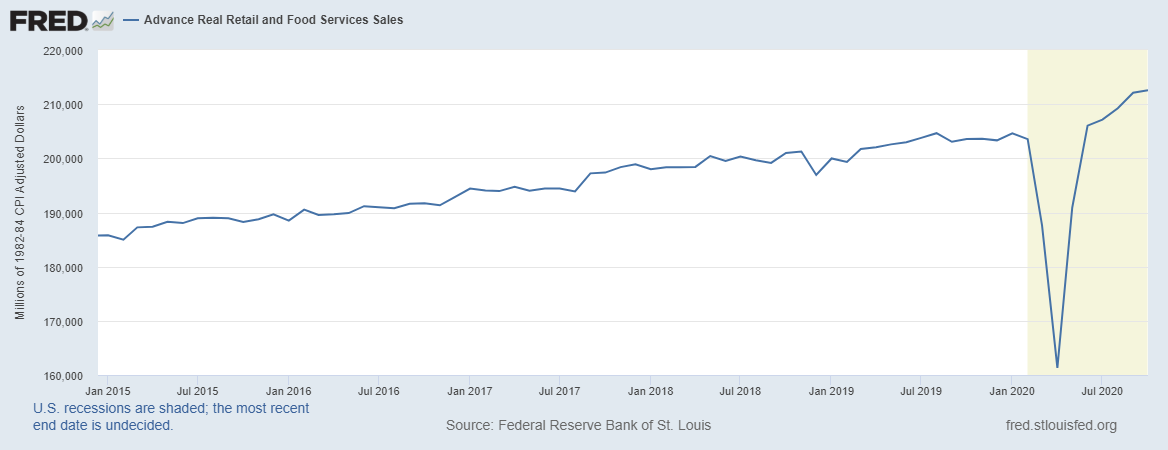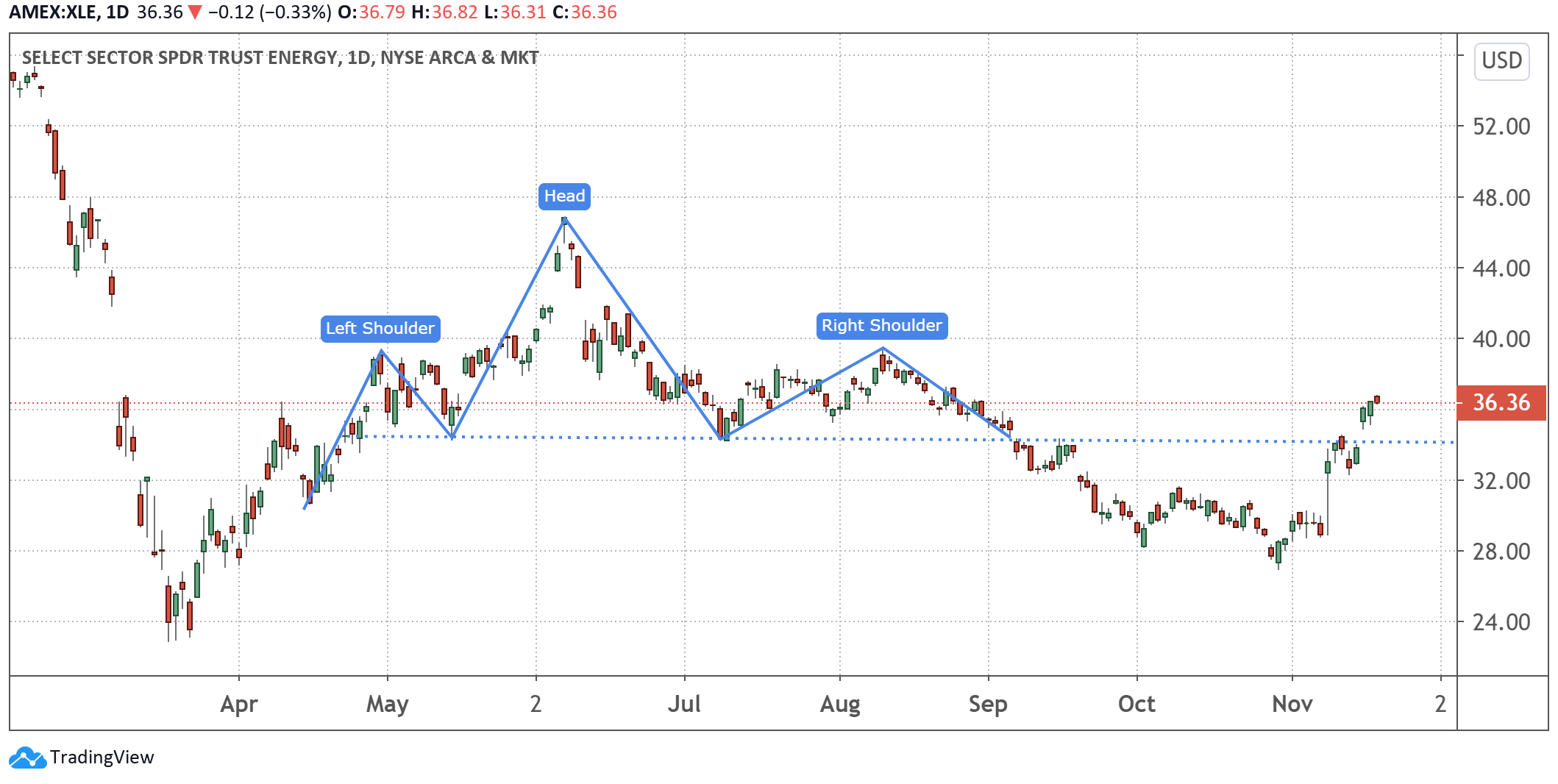As we mentioned last week, the market is performing well. There are even signs that the rally is broad enough to avoid a short-term decline. However, because the underlying fundamentals are still weak — and taking into account recent news about slowing retail sales — we should set expectations for a flat channel after this week’s breakout.
Our stance may sound a little odd considering the stellar performance in the major indexes over the last few days as investors have rejoiced at the good news about Covid-19 vaccines.
However, although we are excited about progress toward an end to the pandemic, retail sales numbers this week show that some of the support for the market is eroding in other areas.
Retail Sales
We had a few big retail reports this week, including Walmart (NYSE:WMT) and Home Depot (NYSE:HD) on Tuesday. Both companies exceeded expectations, but warned about future demand. The U.S. Census Bureau also reported month-over-month retail spending for October on Tuesday, which missed growth estimates by 40%.
As you can see in the following chart, retail spending took a big hit when the Covid-19 pandemic hit the U.S. in the first and second quarters this year. On the surface, the chart seems to imply that consumers have made up the losses and spending growth has continued, but that is only half true.

Since spending started to rise again in May, the U.S. economy is still down $51.3 billion in spending that would have otherwise happened.
The pandemic created a deficit of a little over $75 billion, to put this in perspective.
During the 2008-2009 recession, the deficit in consumer spending grew to nearly 10 times that size, so we aren’t worried about a collapse of the economy at this point, but the slowing rate of growth means significant gains in the market are less likely in the short term.
We still plan to keep some exposure to the retail sector, but we will continue to focus on companies that are likely to do well if lockdowns and other restrictions become common. Those pandemic risks are some of the reasons we are still very bullish on our positions in Chegg (NYSE:CHGG), Logitech (NASDAQ:LOGI) and Starbucks (NASDAQ:SBUX).
Stimulus
The drama following the vote has distracted investors from the 900-pound gorilla in the room — another round of stimulus. Both Republicans and Democrats seem to favor a stimulus bill, but the amounts range from $500 billion to $2.2 trillion.
With many unemployment benefits due to expire next month, this could be the issue that makes or breaks the market this year.
At this point, we feel that some stimulus package passing by January is very likely. However, we are concerned that the amount of stimulus that passes both houses of Congress will miss the amount the market has “priced in.” We agree with Deutsche Bank analysts that the baseline assumption is probably in the $750 billion range, which makes the risk of a big disappointment a little less likely, but still an issue to consider.
In our view, this uncertainty will keep basic-materials stocks, equipment makers and most financial stocks in a range-bound market.
Although we regret that there might be some opportunity cost if we are called out on our Bank of America (NYSE:BAC) covered calls next week, the timing for reducing our exposure to the financial sector is about right. The fact that we’re getting out of the trade with some excellent profits from our many covered calls will help soothe any pain.
As you can see in the following chart, although energy stocks have enjoyed a nice rebound this week, the sector, as represented by the SPDR Energy Sector ETF (NYSEARCA:XLE), is approaching the shoulders of the “head-and-shoulders” pattern that sent the fund to its lows in October.

From a technical perspective, we think sectors like this are at resistance and will underperform unless the stimulus is much larger than expected.
The Election
As we mentioned previously, the post-election court fights and the Twitter (NYSE:TWTR) and press conference accusations of fraud have probably distracted many investors from other issues facing the market. That is entirely understandable, and we have been asked a lot of questions about potential risks this might create for the market.
At this point, the court cases seem to be losing steam as more of them fail and vote recounts in Georgia and audits in Pennsylvania reached their completion.
We stand by our comments we made on Oct. 28.
Uncertainty around a presidential transition is rare, but it happened with Bush v. Gore in 2000. The market survived.
In the 2000 presidential election, the market was already in decline, and the uncertainty didn’t help. But traders assumed the U.S. government’s institutional strength would keep things stable. We believe something similar is happening this time. We expect that any remaining uncertainty about the election will be resolved before the Dec. 8 “Safe Harbor” deadline ahead of the meeting of the electoral college.
The Bottom Line
As we mentioned last week, now that the major indexes have exceeded their prior highs, we think there will be some temporary profit-taking where prices may retrace a little or trend flat. If the S&P 500 declines in the short term, we recommend watching 3,400 as support. If that level holds, we would likely want to add more bullish exposure to the portfolio.
American Thanksgiving is next week, and it is usually a slow one for the market, which is good because it gives us some breathing room to get ready for the employment report for November that will be released on Dec. 4.
A slow week is usually good for option sellers like us because we can be pickier about our entry and exit prices.
On the date of publication, John Jagerson & Wade Hansen did not hold (either directly or indirectly) any positions in the securities mentioned in this article.
John Jagerson & Wade Hansen are just two guys with a passion for helping investors gain confidence — and make bigger profits with options. In just 15 months, John & Wade achieved an amazing feat: 100 straight winners — making money on every single trade. If that sounds like a good strategy, go here to find out how they did it. John & Wade do not own the aforementioned securities.
